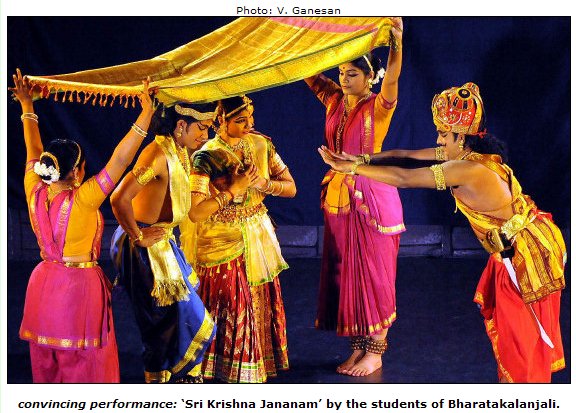With perfect finish
By Leela VenkataramanFriday Review Chennai and Tamil Nadu, The Hindu, Friday, Jan 16, 2009
http://www.hindu.com/fr/2009/01/16/stories/2009011650150300.htm
Bharatakalanjali's ‘Sri Krishna Jananam' was like seeing a Kalakshetra production unfold, under a different banner. And no wonder for it was choreographed by Prof. A. Janardhanan whose entire career was with Kalakshetra and the music was composed by S. Rajaram, former director of Kalakshetra and some Kalakshetra students were also involved in the presentation along with students of the Dhananjayans.

Similarity in tone
With Sai Shankar's voice unleashing a host of rakti ragas flowing in smooth succession, the Kalakshetra feeling was complete.
With the Dhananjayans spearheading the endeavour, the similarity in tone should not really come as a surprise.
The best aspect of the presentation was the finished dancing with no faulty profiles of movement. Among the cast, the most convincing performances were by Gopu Kiran as a powerful Kamsa, Divya as a sensitive Devaki and Gayatri as the Sutradhari also participating in the group dance sequences.
Shafeeq as Vasudeva could have been more animated. The Kamsa/Devaki scenes were by far the best.
Sometimes, the length of appearance has nothing to do with the significance of the role.
For instance, the two guards outside the room where Devaki and her husband are incarcerated, in a fleeting sequence, created a lingering impact.
Effective choreography
The scene of dancing waves with river Jamuna parting to make a pathway for Vasudeva to go to Gokul with Vasu's hood providing the umbrella, sheltering the newborn from the angry rains and thunder, though very simply choreographed had the desired effect.
The stage setting generally effective in simplicity, in the extra black curtain, spoilt the clean look of the performance arena with hanging strings visible from the audience. With Shanta Dhananjayan conducting the recital, Sai Shankar and Aditi provided the male and female singing support, the well rehearsed musical team comprising Ramesh Babu (mridangam), Sunil Kumar (flute), Eashwar Ramachandran (violin) and Jaya Shankar weilding a variety of percussion instruments - the mridangam, the khol and the tabla.
With Sai Shankar's voice unleashing a host of rakti ragas flowing in smooth succession, the Kalakshetra feeling was complete.
With the Dhananjayans spearheading the endeavour, the similarity in tone should not really come as a surprise.
The best aspect of the presentation was the finished dancing with no faulty profiles of movement. Among the cast, the most convincing performances were by Gopu Kiran as a powerful Kamsa, Divya as a sensitive Devaki and Gayatri as the Sutradhari also participating in the group dance sequences.
Shafeeq as Vasudeva could have been more animated. The Kamsa/Devaki scenes were by far the best.
Sometimes, the length of appearance has nothing to do with the significance of the role.
For instance, the two guards outside the room where Devaki and her husband are incarcerated, in a fleeting sequence, created a lingering impact.
Effective choreography
The scene of dancing waves with river Jamuna parting to make a pathway for Vasudeva to go to Gokul with Vasu's hood providing the umbrella, sheltering the newborn from the angry rains and thunder, though very simply choreographed had the desired effect.
The stage setting generally effective in simplicity, in the extra black curtain, spoilt the clean look of the performance arena with hanging strings visible from the audience. With Shanta Dhananjayan conducting the recital, Sai Shankar and Aditi provided the male and female singing support, the well rehearsed musical team comprising Ramesh Babu (mridangam), Sunil Kumar (flute), Eashwar Ramachandran (violin) and Jaya Shankar weilding a variety of percussion instruments - the mridangam, the khol and the tabla.
